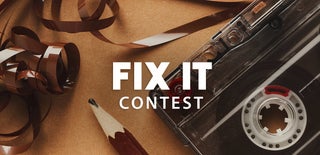Introduction: Towing/Hauling Trailer Restore
This is the BEFORE & AFTER view of the trailer.
Step 1: Assess What You Have
Start by looking over your trailer thoroughly. Determine what is salvageable and what is not.
Sketch out a basic drawing of the trailer, and take time to measure each section - and put the measurements on the sketch.
Take pictures of everything. This saved me countless trips to the store - because I could simply pull up the picture of the tail light assembly, tongue, wheel size, electrical fitting, etc. and make sure I picked up the correct thing.
I needed:
- All new light assembly for the rear tail light
- New wiring harness to plug into the towing vehicle
- New rims and tires for the trailer
- All new wood for the body and sides
- Wire brush to remove the rust
- Primer and paint for the metal
Step 2: Strip, Clean, Paint & Electrical
A lot of steps at once - but they all flowed together.
- Disassemble the wood portions. Save the large bolts for reuse if possible - take them to the store to match and replace if necessary.
- Sweep off the entire trailer. Caked up dried mud, grease and debris will be embedded beneath the boards and has to be removed before it can be cleaned up.
- Thoroughly clean all the surfaces with a degreaser (Dawn does wonders) and dry.
At this point, remove the electrical portions (and wiring if necessary).
- Wire brush the rust to metal.
- Treat bare metal with a rust inhibiting primer.
- Paint ALL metal surfaces. I went back with the original cherry red color.
Attach the new brake light assembly and rewire with the hauler adapter plug. The electrical portions are clearly labeled on the packaging and very easy to follow. My son Matthew actually put the lights together!! Be sure and have wire nuts, black electrical tape and black zip ties to constrain things where you want them.
Step 3: Put Down the Flooring.
I recommend you get boards that are as long as needed. These needed only to be trimmed 2" to fit. I secured the boards with metal tapping screws to the metal frame beneath.
I used 10 - 2x6 boards.
Step 4: Matching the Prior Sides - Cut and Secure
This went quickly.I cut the 2x4's for the holder (slots that you drop the sides into). I cut 2x6's to create the framing for the front and sides.
We built 1 side at a time, the front, then the back. We spaced the boards equa-distant and secured them to the standing 2x4s (already inserted and secured into the slot).
Step 5: Completing the Build...
We finished the floor and rails, and re-added the hoops. They were rusty - so needed to be wire brushed and repainted. Added new bungie cords to restrap.
The back of this trailer is easily removable - sliding in and out as needed.
I installed the NEW rims and tires. These 2 rims/tires I picked up from Tractor Supply.
Step 6: All Done!
We were excited to see the trailer the next morning "in the light"... I had 1 scrap board I reused on this project (easy to spot). Trailer turned out looking great and ready to haul my boys water stuff, bikes and dirt bikes for several more years of use!

Participated in the
Fix It Contest











